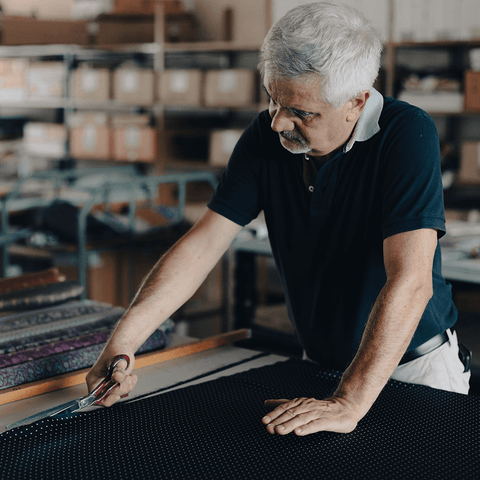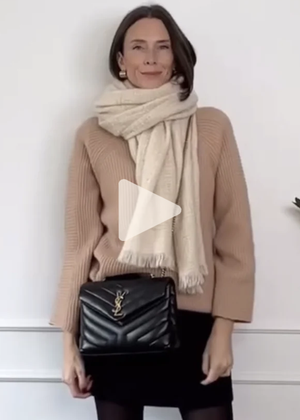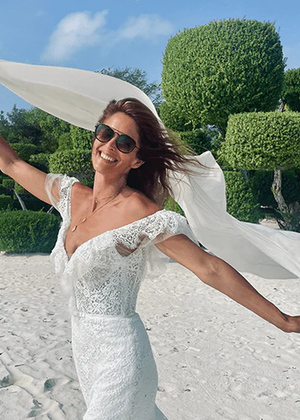Our bestselling collection of Italian silk and wool accessories is produced by a small family business based just outside Florence. We have successfully collaborated with this passionate family of designers and craftsmen for over 10 years due in large part to our shared values for quality fabrics, timeless designs and Italian food and wine.

We are about to launch our latest collaboration for our collection of printed silk, wool and cashmere scarves and to mark the launch we interview the head of the family, Massimo, to find out more about their heritage and how the collection was made.
Can you tell us about the history and heritage of your company?
We were founded in 1953, when Mr. Silvano Michelassi, my father, decided to start his own business after a few years of practice in a small tie workshop in the city. He was worked with my mother Valentina for many years, until I joined the business, soon followed by my wife Barbara. My father called his workshop Florence Style because he loved our city, and my I feel privileged in pursuing his original aim to recount Florence through our neckties and scarves.

What are the most important aspects of the accessoires you produce?
For sure the most important aspect, in my opinion, is that we still work by hand after so many years and this will still last for a long time. I like the craftmanship of our creations because first of all this allows us to keep under control every inch of fabric used, and at the same time every little imperfection and irregularity is the warranty that wise hands have sewn that product. Then, another aspect I always like to underline, is that our collections completely follow our taste, I spend a lot of time studying the desings and color so that they fully express what we appreciate and the feelings we want to transmit with our accessories

What type of fabrics do you use and where do you source them?
Our fabrics are mainly made of natural fibers, first of all silk but also wool, cachemire, cotton and linen. For a couple of years we’ve been using also modal, which is an artificial fiber obtained from cellulose very soft and perfect for scarves. We work both with woven fabrics and printed ones, depending on what kind of item we think fits better to every single design. Every fabric we use comes from the same suppliers in Como my father used to work with; this grants us the certainty of the maximum quality, we have trusted relationship with them so they perfectly know what we expect when receiving the cloths.

Can you tell us about the printing process for your fabrics?
The printing process is composed by several phases: the first one is in the weaving mill, where the printing ground is created on a loom as a normal woven fabric but in general only with white threads; after that, the raw fabric is treated with specific substances whose task is to prepare the threads to receive the inks during the effective printing process. Then, the fabric is transported in the printing house, an enormous building with long printing tables (around 35 meters) where the magic take place, the digital printing machine work exactly like a normal inkjet printer we all have in our houses, but on a slighlty bigger scale. In the end, after every desing is printed, there is maybe the most important phase of the production, the finishing process: this in fact permits the inks to be fixed to the fabric fibers so that there isn’t risk of undesired stains on shirts or jackets, and above all to be sure that the fabrics are antiallergic.


Can you tell us about the process of transforming the fabric into the finished accessory?
First of all the fabrics is checked to verify there aren’t defects and the print is straight (meaning that the axis of the desings follows the direction of the ground weaving. After this the fabric is cut depending on what we have to produce, following models for the neckties, freehand for scarves and pocket squares. For ties we continue with assembling the three necessary fabric pieces, applying the tipping, inserting the innerlining, stapling the necktie and then the final stitching to lock the back of the tie. For pocket squares we immediately proceed with hand rolling the edges, while for scarves we can proceed in two ways:
-
for split items we hand roll the long sides and make frindges on the shorter ones;
-
for tubular scarves instead, first of all we staple the two fabric pieces to match them perfectly, in order to avoid folds or excess fabric; after that we sew them at the sewing machine taking off a pin at a time on the longer sides, while make frindges or applying hand knotted tassels on the shorter sides.
What pieces from this years collection for BLACK are you most excited about?
I can say that I am particularly proud of the silk and wool scarves you selected from our range, as I personally created the designs, colors and general aspect of this part of the collection. Usually the set-up of scarves desings is a little bit more difficult because you have to play with the right proportions, decide if you want to add plain borders or matching patterns to create contrast borders. This time instead, starting from some neckwear desings, I adapted them to the right size and I chose the colors of every single item of the pattern. I deeply studied the aspect of the finished scarf once at the neck so that it has the perfect fitting: I can say they are my creature!







